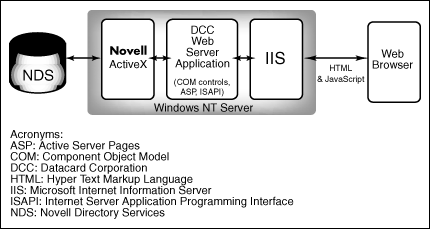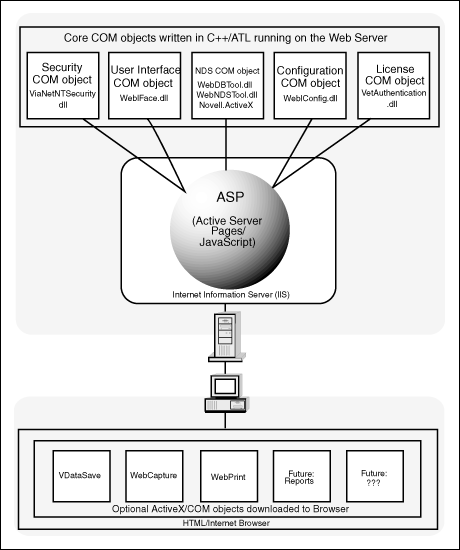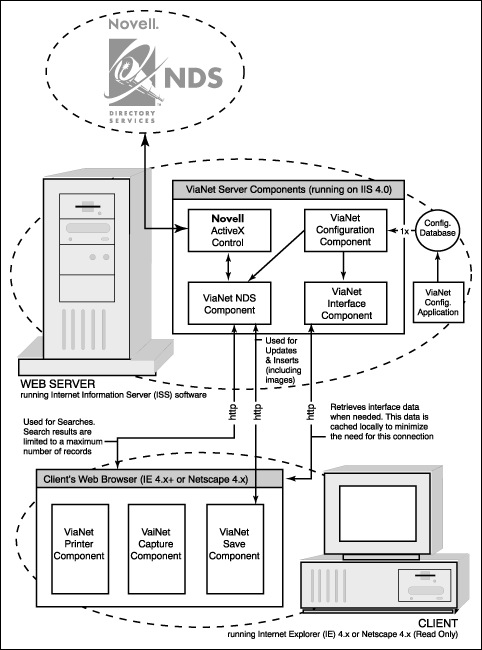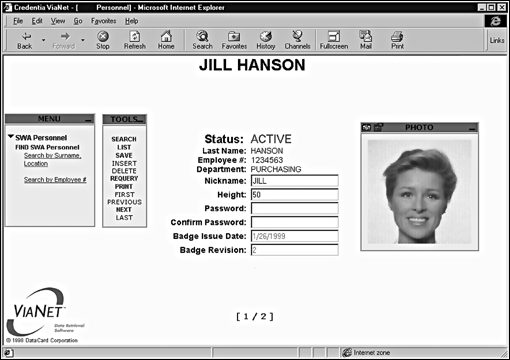Developer Tools: Credentia ViaNet/NDS
Articles and Tips: article
01 Sep 1999
"Developer Tools" is a new section that will feature one or more products from Novell partners each month. This month we focus on Credentia ViaNet/NDS, a Web-based application that allows you to retrieve data and full-color images from NDS or any ODBC Data Source from within Microsoft Internet Explorer or Netscape Navigator Web browsers.
Introduction
Editor's Note: With this issue of Novell Developer Notes, we introduce a new monthly section called "Developer Tools." Each issue we will feature one or more products from Novell partners. By submitting articles for publication in Developer Notes, you can deliver timely technical information about your product to a worldwide audience of in-house programmers, commercial software developers, and consultants. In addition to hard-copy subscriptions and distribution through the Novell DeveloperNet program, Developer Notes are available on the World Wide Web, yielding a combined potential readership of over 180,000 key members of the networking community.
Participation Requirements: All Novell partners are invited to submit developer-oriented articles about their tools or solutions and the benefits they offer to network programmers. All material published in Developer Notes must be technical in nature and relevant to current issues facing Novell developers. Main areas of emphasis are topics such as APIs, Java, development tools, and Novell Directory Services (NDS)-based solutions. Partner submissions should have joint partner and Novell content, and focus on helping readers create network applications more effectively.
For More Information Contact: Larry Morris Managing Editor, Novell Developer Notes Novell, Inc. 122 E. 1700 South MS PRV-E242 Provo, Utah 84606 Phone: 801-861-6517 Fax: 801-861-4123 E-mail: lmorris@novell.com
This edition of Developer Tools deals with Credentia ViaNet/NDS.
Credentia ViaNet/NDS
Credentia ViaNet is a standard Web-based application that runs with Microsoft Internet Information Server. It allows users to retrieve data and full-color images from NDS or any ODBC Data Source from within the Microsoft Internet Explorer or Netscape Navigator Web browsers. Data Insert/Update, Image Capture, and Card Issuance are supported in Internet Explorer via a standard ActiveX control interfacing with the Credentia QuikWorks platform. The application and card formats are located on one central server for easy, secure access and to prevent fraudulent card issuance.
Product Overview
Figure 1 shows a graphical overview of Credentia ViaNet/NDS.
Figure 1: The Credentia ViaNet/NDS identity solution.

The Credentia ViaNet application is the basis for data entry, retrieval, and card printing via a Web-based interface. The design is built on the premise that all applications reside on a Web server and are interfaced via a Web browser.
Figure 2: Credentia ViaNet's Web-based interface.

The main source of content displayed on a Web browser by ViaNet applications will be ASP (Active Server Pages) created with JavaScript and HTML running on IIS (Internet Information Server). Calls are made from ASPs to COM components written in Visual C++ (ATL or MFC) or Visual Basic. These components will provide the majority of the functionality of ViaNet applications.
Figure 3: Core COM objects.

The client browser sends a request with the search criteria to the Web server. This request is handled by the ViaNet NDS Component, which using the Novell ActiveX control, will select all columns (object properties) from the tree where the search criteria is true. If a single record is returned from NDS, all columns are sent back to the client; however, if multiple records are returned only the columns that are needed by the list-view will be returned for each row (not the image). When the user selects a single record from the list-view, the client sends another request for the entire record using the key field as the search criteria. After receiving the single record, the client sends an additional request for each of the images (usually 20 to 30KB) that must be shown when viewing this record. Each additional request translates into a search for a single record.
The ViaNet Save Component sends a request to the Web server with the fields that have been edited. If images have been captured the data for each of these is formatted into this request as well. This request is handled by the Vianet NDS Component, which will search for the record and perform the update. An answer of either Success or Failure is returned. Upon success the client re-queries (searches) in order to update the list and to ensure that our current record accurately reflects what is in the database after the update.
Figure 4: The ViaNet NDS component.

Southwest Airlines' Implementation of ViaNet
Southwest Airlines is a long time user of NetWare and NDS, with over eighty servers and 7,000 desktops in its network. In the spring of 1998, budget was approved for a project to rebadge all company personnel. The project is substantial, rebadging over 28,000 employees in 54 locations, including new ID pictures.
"We evaluated sources for rebadging technology and selected Credentia," said Jan Killion, Resource/Projects Team Leader for Southwest. "Their ViaNet product is Web-enabled, which is important to us. We wanted to update our badging technology, and we especially liked the process of capturing photographs digitally. A badging process using digital photograph capture will provide long-term benefits for the company."
"Credentia explained that their established approach is to store data and images in their own database," said Lee Roth, Southwest's LAN and Security Services Manager, "but our experience with NDS gave me another idea. I knew that NDS has the power to store all the necessary images and data, including passwords. Not only would using our enterprise directory save us from having to deploy a new server, but the openness and flexibility of NDS could then be exploited to create a sweeping new authentication and security system for the company, with ViaNet's directory-enabled data as its basis. We asked if Credentia could alter its software to substitute NDS for their own database."
After receiving this valuable technical input from a large potential client, Credentia reacted enthusiastically to Roth's suggestion. "We realized that Southwest was just the first of many potential Credentia customers who would benefit in similar ways by leveraging their NDS schema as ViaNet's database," said Scott Kullman, Software Engineering Manager for Credentia.
In late 1998, Credentia commenced development. "Our first step was to ask Novell for assistance," said Jim Walters, Credentia's Program Manager. "They helped us tremendously by explaining the NDS components and directory services issues involved. As a result of their help and the tools in the Novell Developer Kit, we were able to complete the implementation in just sixty days."
Credentia ViaNet/NDS allows customers to capture employee images and additional demographic information anywhere in the world over the Internet, store them as employee user objects in NDS, and instantly issue employee corporate identification badges.
ViaNet runs with Microsoft Internet Information Server, and supports both popular Web browsers. The application and card formats are located on one central server for easy, secure access and to prevent fraudulent card issuance.
In early 1999, Credentia delivered ViaNet/NDS to Southwest Airlines. "The efficiency of this process has proven to be everything we expected," said Killion. "Already we have about 20 percent of our employees rebadged, and we expect to finish all employee groups by fall."
Figure 5: ViaNet Data View screen installed at Southwest Airlines.

"We definitely saved money by using NDS as ViaNet's database, starting with a new server and then adding in all the required support and system administration costs," said Roth. "However, the long-term benefits are far greater. Because NDS is completely open and flexible, we can develop new applications that leverage employee data for other purposes. We're positioning NDS as a single authentication source for internally developed applications. Our internal customers can gain access anywhere, any time over the Web, using a single sign-on for these applications. We're expanding the scope of NDS so that it becomes the de facto authentication database for the company."
"Our partnership with Novell is a great thing for both companies," added Walters. "For us, it adds credibility and opens up a large new base of prospects who employ NDS. For Novell, it extends the utility of NDS into a new kind of benefit area and makes it even more vital to customers. We're great strategic partners."
For more information about Credentia solutions, please visit http://www.credentia.com/.
* Originally published in Novell AppNotes
Disclaimer
The origin of this information may be internal or external to Novell. While Novell makes all reasonable efforts to verify this information, Novell does not make explicit or implied claims to its validity.